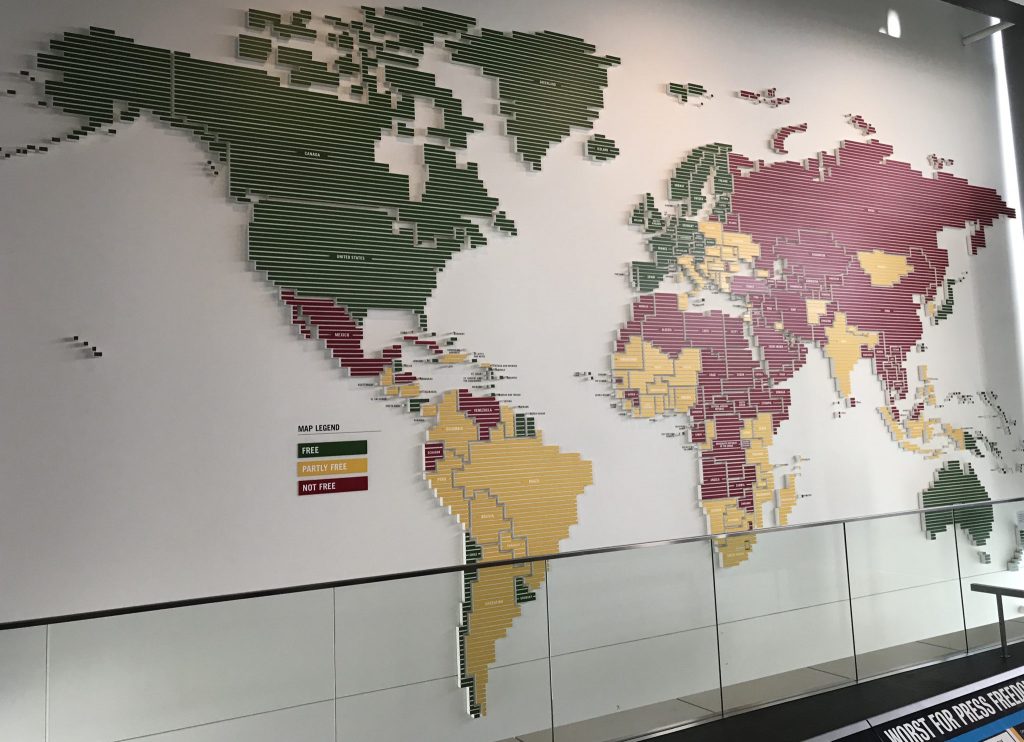Note: The opinions and comments stated in the following article, and views expressed by any contributor to In Homeland Security, do not represent the views of American Military University, American Public University System, its management or employees.
By Susan Hoffman
Contributor, In Homeland Security
Last weekend, I visited the Newseum in Washington, D.C. The exhibits vary widely in this museum. One exhibit is dedicated to the World Trade Center/Pentagon attacks on 9/11 and another is about the Berlin Wall and its eventual demolition. There is also a display of Pulitzer Prize-winning photographs that explains the stories behind them and why those photographs made a difference to government or society.
But the exhibit that impressed me the most was a 36-foot World Press Freedom map with countries in three different colors. Green represented a country with a free press; yellow or red indicated that a particular country had a partly free press or a press without freedom.
The map is updated annually by museum staff. Countries change color, going from less free to more free, or vice versa.

What shocked me was how few countries on this map were in green. Yellow and red dominate the map, indicating that the global press isn’t as free as we might think it is.
News Spreads Globally, But Is It Always True?
We’re in an era where the media’s truthfulness is under constant challenge. “Fake news!” is a cry we often hear, particularly in social media. Most of the time, people who promote something as fake news also fail to provide a rationale for why the news is fake. That person appears to be deliberately baiting others to get a reaction or attempting to acquire clicks, likes and shares.
Everyone with a smartphone or computer can publish nowadays. Whether that person works for a professional news organization or not, he or she can be read around the globe.
But that doesn’t mean that any publisher — professional or not — shouldn’t be held to a standard of truthfulness. If you publish it online, other people will quickly let you know what they think and challenge you, holding you accountable for what you say.
It’s also true that some news organizations are unashamedly partisan. Others take the time to carefully fact-check their stories to ensure that readers get news with the greatest possible accuracy.
Before We Cry ‘Fake News!’, Take the Time to Remember the Sacrifices Others Have Made
A short distance from the Press Freedom Map is a memorial dedicated to the more than 2,300 reporters, editors, photographers and broadcasters who died attempting to get the most accurate news story they could. Some of the names, like The Wall Street Journal’s Daniel Pearl, are familiar. Pearl died at the hands of Islamist terrorists in 2002.
The Newseum website notes that each year, it “selects a representative group of journalists whose names are added to the memorial and whose deaths illustrate the dangers faced by journalists around the world.” I wouldn’t be surprised if the name of Washington Post writer Jamal Khashoggi and his story join them soon.
Everyone has their own opinions in regard to the news media and the stories they cover. We won’t always agree with what others say about news and history, and we will be in constant debate about what is right and what is wrong.
But at the same time, let’s be thankful that in this country, freedom of speech and particularly freedom of the press still exist. Other countries are not so lucky.
